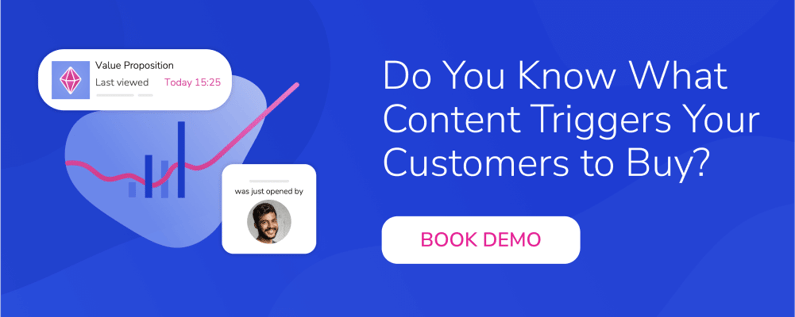Buyer engagement is the key to building strong relationships, driving conversions, and ultimately achieving your business goals. Now that we have a solid grasp on what buyer engagement entails, let's look into the key metrics you need to track and why these are categorized into specific areas: website traffic and engagement, social media, email, sales content, and conversion and sales performance.
In this blog post, we'll delve into key metrics across different channels, the benefits of measuring these metrics, and buyer engagement software you can use to track your progress.
By the end of this post, you'll have a clear understanding of how to leverage these metrics to drive buyer engagement. Let's dive in!
Here's a summary of what you'll find in this blog:
Why Tracking Buyer Engagement is Important
Buyer engagement is the depth and quality of interaction a customer has with your brand. And tracking buyer engagement offers numerous benefits.
Engaged customers are more likely to make repeat purchases, larger orders, and become brand advocates, leading to positive word-of-mouth and increased customer acquisition.
Tracking buyer engagement improves your bottom line in various ways: through increased revenue, improved customer satisfaction, and strengthened brand loyalty.

5 Key Metric Groups to Track Buyer Engagement
To gain a comprehensive understanding of buyer engagement, we categorized the metrics into five key areas: website traffic and engagement, social media, email, sales content, and conversion/sales performance. This categorization allows for a holistic view of the buyer journey, enabling data-driven decisions to improve business outcomes.
Website Traffic and Engagement MetricsWebsite traffic and engagement metrics offer valuable insights into how visitors interact with your online presence. By understanding these metrics, you can identify areas for improvement, optimize your website content, and enhance the overall user experience. |
Bounce Rate
This metric measures the percentage of visitors who leave your website after viewing only one page. A high bounce rate might indicate poor content relevance, slow loading times, or a confusing website structure.
Average Session Duration
This metric shows the average time visitors spend on your website during a single session. A longer average session duration suggests higher engagement and interest in your content.
Pages per Session
This metric reveals the average number of pages a visitor views during a single session. A higher number indicates greater exploration of your website.
Scroll Depth
This metric measures how far down a page visitors scroll before leaving. It helps you understand which content sections are most engaging.
Click-Through Rate (CTR)
This metric indicates the percentage of visitors who click on a specific link or call-to-action. A high CTR suggests effective content and persuasive calls to action.
Social Media Engagement MetricsSocial media has become a vital channel for reaching and engaging with potential buyers. With many of today's stakeholders and buyers having grown up with social media, it's a key channel for connecting with your target audience. By tracking key metrics, you can gain valuable insights into your audience, measure the effectiveness of your content, and optimize your social media strategy. Social media engagement metrics provide a window into how your target audience interacts with your brand, allowing you to identify trends, preferences, and opportunities for improvement. |
Impressions and Reach
These metrics show the total number of times your content was displayed and the number of unique users who saw it.
Engagement Rate
Engagement rate is a crucial metric that measures the level of interaction your content receives from your audience. It's a percentage calculated by dividing the total number of interactions by your total number of followers. This metric measures the percentage of your audience that interacts with your content through likes, comments, shares, or clicks.
Click-Through Rate (CTR)
Similar to website CTR, this metric indicates the percentage of users who click on a link in your social media post.
Follower Growth
Measures the increase in your followers over time, showcasing your brand's ability to resonate with your audience and attract new followers. Compare your growth to industry benchmarks and identify areas for improvement to optimize your content and advertising strategy and expand your reach.
Email Engagement MetricsEmail marketing remains a powerful tool for nurturing leads and building customer relationships. As a direct channel to buyers, email provides an opportunity to deliver personalized messages, share valuable content, and drive conversions. |
Open Rate
This metric measures the percentage of recipients who open your email. A high open rate indicates relevant and compelling subject lines.
Click-Through Rate (CTR)
CTR focuses on the overall effectiveness of your email campaign. It measures how many people clicked on any link in your email, regardless of whether they opened the email first. A high CTR indicates that your email subject line, preview text, and content are compelling enough to entice recipients to click through and explore further.
Click-to-Open Rate (CTOR)
CTOR is more specific to the content of your email. It measures how many people who opened your email actually clicked on a link within it. A high CTOR suggests that the content of your email is relevant, engaging, and encourages recipients to take action.
Bounce Rate
This metric indicates the percentage of emails that couldn't be delivered. A high bounce rate can indicate a variety of issues, such as invalid email addresses, email filtering, or server problems. To reduce bounce rates, ensure your email list is clean and up-to-date, optimize your email content to avoid being flagged as spam, and maintain a reliable email server.
Unsubscribe Rate
This metric shows the percentage of recipients who unsubscribe from your email list. A high unsubscribe rate can be a sign that your content is not resonating with your audience or that you are sending emails too frequently. To reduce unsubscribes, consider segmenting your audience, providing value in your emails, and allowing easy unsubscribes.
Conversion Rate
Conversion rate is a key metric for measuring the effectiveness of your email marketing campaigns. A high conversion rate indicates that your emails are driving desired actions, such as purchases, sign-ups, or form submissions. To improve your conversion rate, ensure your emails are well-designed, targeted to the right audience, and include a clear call to action.
Sales Content Engagement MetricsSales content plays a crucial role in influencing buyer decisions. By tracking how potential customers interact with your sales materials, you can gain valuable insights into their preferences, interests, and pain points. This information can be used to refine your sales process and improve conversion rates. |
For example, tracking content downloads can reveal which topics are most relevant to your audience and help you identify potential pain points. By analyzing time spent on content, you can gauge how engaging your materials are and identify areas where you can provide additional value. Content shares indicate which content resonates with your audience and can help you identify potential influencers or advocates.
Furthermore, tracking lead generation from sales content helps you measure the effectiveness of your content in driving conversions and identifying high-quality leads. Finally, conversion rates provide insights into the effectiveness of your content in moving buyers further along the sales funnel.
By analyzing these metrics, you can identify which sales content is most effective, tailor your content to specific buyer personas, and optimize your sales funnel.
Content Downloads
This metric measures the number of times your sales content, such as whitepapers, eBooks, or case studies, is downloaded. A high content download rate indicates that your sales content is relevant and valuable to your target audience. This can indicate the buyer's interest and can signal where they may be in the sales journey, allowing you to tailor your sales approach.
Time Spent on Content
The average time spent on your content is a good indicator of its quality and engagement. If your audience is spending a significant amount of time consuming your content, it suggests that they find it informative, interesting, and relevant to their needs at that given stage.
Content Shares
This metric measures how often your sales content is shared. content shares can indicate that new stakeholders may be joining the decision-making process, suggesting that your content is reaching the right people and influencing their purchasing decisions.
Conversion Rate and Sales MetricsConversion rate and sales metrics are the ultimate indicators of your sales performance and the effectiveness of your buyer engagement efforts. They provide a clear picture of how well you're converting leads into customers and how efficiently your sales process is operating. |
Analyzing both conversion rate and sales metrics gives you a comprehensive understanding of your sales performance and identify opportunities for improvement. But remember: Correlation doesn't always equal causation. While these metrics provide valuable insights, it's essential to consider other factors that might influence performance, such as market conditions, economic trends, and competitive landscape.
While these metrics provide valuable insights, it's essential to consider other factors that might influence performance, such as market conditions, economic trends, and competitive landscape.
Conversion Rates
- Overall Conversion Rate: This metric measures the percentage of website visitors or leads who complete a desired action, such as making a purchase, scheduling a demo, or signing up for a newsletter.
- Sales Conversion Rate: This metric specifically measures the percentage of qualified leads who become paying customers.
- Marketing Qualified Lead (MQL) to Sales Qualified Lead (SQL) Conversion Rate: This metric assesses the efficiency of your lead nurturing process and determines how effectively you're converting MQLs into SQLs.
- Customer Acquisition Cost (CAC): This metric calculates the total cost of acquiring a new customer. By comparing CAC to customer lifetime value (CLTV), you can determine the profitability of your customer acquisition efforts.
Sales Metrics
- Sales Pipeline Velocity: This metric measures the speed at which deals move through your sales pipeline. By analyzing pipeline velocity, you can identify bottlenecks and accelerate the sales process.
- Average Deal Size: This metric represents the average revenue generated per deal. Tracking average deal size helps you identify opportunities to increase sales and profitability.
- Sales Cycle Length: This metric measures the average time it takes to close a deal. By analyzing sales cycle length, you can identify areas for improvement and streamline your sales process.
- Win Rate: This metric calculates the percentage of deals closed compared to the total number of opportunities. A high win rate indicates effective sales execution.
- Sales Quota Attainment: This metric measures the percentage of sales representatives who achieve their sales quotas. It helps you assess the performance of your sales team and identify training needs.

The Power of Buyer Engagement Metrics and Sales Enablement
As sales leaders, you can gain a deeper understanding of your buyer's journey and identify opportunities for improvement by tracking and analyzing the key metrics outlined in this blog post.
However, to truly maximize the potential of buyer engagement data, sales enablement nowadays not only streamline your sales processes but also come with powerful sales content analytics features. These tools, such as Showell, can provide real-time insights into buyer behavior by tracking their interactions with sales materials shared by salespeople.
Sales enablement tools offer several key benefits. They provide instantaneous feedback on buyer interest by tracking their interactions with sales content, allowing for personalized follow-ups based on specific engagement. Additionally, these tools help optimize content strategies by identifying which materials resonate most with buyers, enabling you to tailor your content library accordingly.
Get Showell Free or book a demo today to see how our platform can help you unlock the power of buyer engagement metrics and sales enablement!
Learn more :




